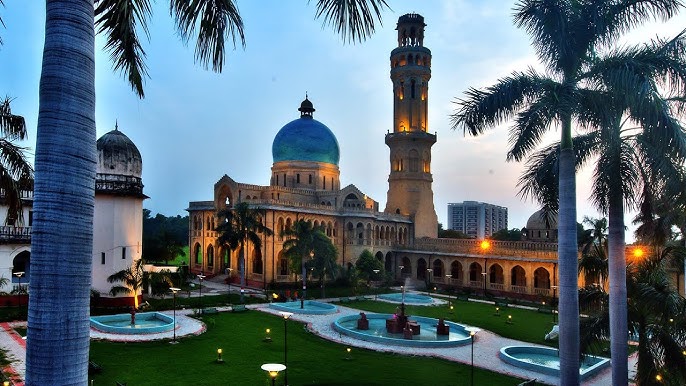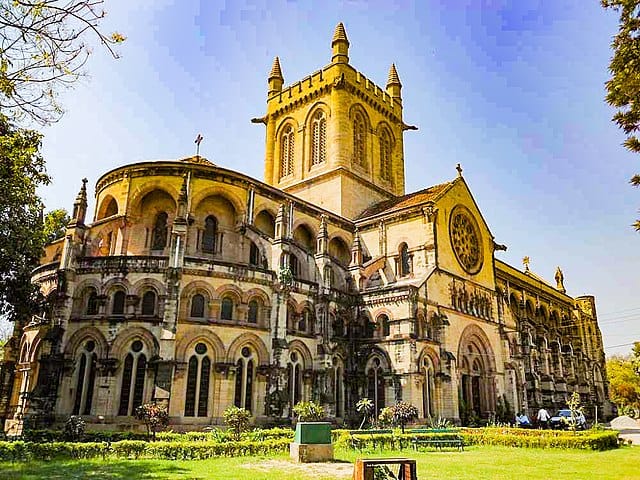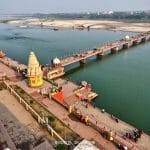Famous monuments in Prayagraj
Prayagraj, formerly known as Allahabad, stands as a confluence not just of rivers but also of civilizations, cultures, and historical legacies. While the city is widely revered for its mythological and spiritual significance, it also holds a distinct colonial charm—one that whispers tales of the British Raj, missionary establishments, and the birth of some of India’s most prestigious educational institutions. In this guide, we explore Prayagraj’s colonial heritage through its churches, universities, and architectural landmarks, offering a window into the city’s rich past.
Famous monuments in Prayagraj

Colonial Footprints: A Glimpse into British-Era Prayagraj
Prayagraj was a significant administrative center for the British East India Company and later the British Crown. It was declared the capital of the North-Western Provinces in the 19th century, which catalyzed the city’s transformation into an urban colonial hub. Wide boulevards, Gothic-style buildings, churches, and government edifices began to dominate the skyline.
Churches of Prayagraj: Echoes of European Faith
1. All Saints’ Cathedral – The Pride of Gothic Architecture
Located at the heart of Civil Lines, All Saints’ Cathedral, also known as Patthar Girja, is a masterpiece of 13th-century Gothic Revival style & Famous monuments in Prayagraj .
- Built: 1871 by British architect Sir William Emerson (who also designed the Victoria Memorial in Kolkata).
- Highlights: Beautiful stained-glass windows, high vaulted ceilings, a pipe organ, and carved wooden pews.
- Still in Use: The church holds regular Sunday services and special masses on Christian holidays.
2. St. Joseph’s Cathedral
Located near the Catholic Bishop’s House, this majestic structure is an important religious and architectural site & Famous monuments in Prayagraj .
- Built: Late 19th century by Italian craftsmen.
- Style: Baroque architecture with Roman pillars, frescoes, and domes.
- Notable Feature: An altar imported from Italy and intricate hand-painted interiors.
3. Holy Trinity Church
Famous monuments in Prayagraj Built in 1839, this is one of the oldest churches in Prayagraj, symbolizing the early days of British rule.
- Design: Military-style colonial structure, with British graves located in its compound.
- Function: Originally served British army personnel stationed in the city.
Colonial Universities & Institutions: Foundations of Indian Intellect
1. University of Allahabad – The Oxford of the East
Established in 1887, University of Allahabad is one of the oldest modern universities in India.
- British Vision: Modeled on the University of Oxford and meant to educate the Indian elite.
- Architectural Marvel: Red sandstone buildings, Gothic arches, and colonial-era lecture halls.
- Legacy: Produced numerous freedom fighters, scholars, and presidents of India.
2. Muir Central College
A core part of the Allahabad University complex, Muir College was inaugurated by Lord Northbrook in 1872.
- Designed By: Sir William Emerson.
- Architectural Style: Indo-Saracenic, blending Mughal, Gothic, and Victorian styles.
- Fun Fact: The college building’s façade is a perfect example of British architectural experimentation in India.
3. Prayagraj Public Library (Thornhill Mayne Memorial)
A hidden gem for architecture lovers and history buffs alike.
- Constructed: 1864, designed by R. Roskell Bayne.
- Current Use: Central library housing thousands of colonial-era books and manuscripts.
- Structure: Scottish Baronial style with sharp turrets and pointed arches.
Government Buildings & Civil Lines: Legacy of Colonial Administration
The Civil Lines area, designed during British rule, stands as the most planned urban space in colonial India.
Key Highlights:
- High Court of Judicature at Allahabad: Established in 1866, it reflects the authority and aesthetic of the British legal system, built in Scottish Baronial style.
- Collectorate Building: Another grand structure, now part of the administrative machinery.
- Old Secretariat Building: Houses various government offices; retains its vintage façade and tall columns.
Civil Lines was home to British officers, judges, and elites. Its broad avenues, gardens, and colonial bungalows still hold onto their historic charm.
Schools & Missionary Institutions
Many elite missionary schools were founded in Prayagraj during the colonial era. They became breeding grounds for leaders of India’s independence movement.
- St. Joseph’s College (Founded 1884): Known for discipline, academics, and colonial architecture.
- Boys’ High School & College (Established 1861): One of the oldest ISC schools in the country.
- St. Mary’s Convent and Bethany Convent School: Established by Christian missionaries for girls’ education.
These institutions not only disseminated Western education but also inculcated values of service, leadership, and ethics.
Colonial Parks & Recreation Grounds
1. Alfred Park (Now Chandrashekhar Azad Park)
Originally built for British recreation, this vast park was the city’s lungs during colonial times.
- Significance: Site where freedom fighter Chandrashekhar Azad died in 1931 fighting British police.
- Monuments Inside: Victoria Memorial Pavilion and Madan Mohan Malaviya Stadium.
2. Company Bagh
A meticulously laid-out garden for British officers, now a popular public park that still retains its colonial layout and botanical variety.
Iconic Colonial Landmarks Not to Miss
- Clock Tower (Ghanta Ghar): Built during the British period; a classic example of Victorian town center planning.
- Ewing Christian College: Originally set up by American missionaries, it carries colonial charm and spiritual heritage.
- Anand Bhawan (former Swaraj Bhawan): Once a private residence for Motilal Nehru, built in colonial style, later transformed into a political nerve center of India’s freedom movement.
Suggested Heritage Walk: Colonial Trail of Prayagraj
To truly immerse yourself in Prayagraj’s colonial past, we recommend a walking trail through Civil Lines:
- Start at All Saints’ Cathedral – admire its architectural beauty.
- Stroll down MG Road and explore Muir College & University Campus.
- Visit Thornhill Mayne Library and adjacent buildings.
- Head to Chandrashekhar Azad Park and relive history.
- End your trail with St. Joseph’s Cathedral and a quiet moment at Holy Trinity Church.
This 3-4 hour walk offers a timeless journey through colonial India nestled within a city of timeless spirituality.
Tips for Travelers & History Buffs
- Best Time to Visit: October to March, when the weather is pleasant for walks and exploration.
- Guided Tours: Opt for heritage walks offered by local historians or tourism boards.
- Photography: Most colonial buildings offer beautiful exteriors for photography; interiors may need permission.
- Stay: Choose heritage properties or hotels in Civil Lines for an immersive experience.
Conclusion
Prayagraj’s colonial heritage is a compelling counterpoint to its spiritual soul. These churches, universities, and landmarks stand as proud reminders of an era that shaped India’s modern identity. Walking through the city is like flipping through pages of a living history book—where every monument, every archway, and every clock tower tells a story of transformation, resistance, and cultural evolution.





